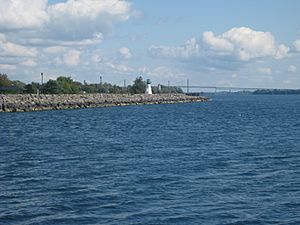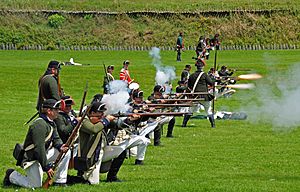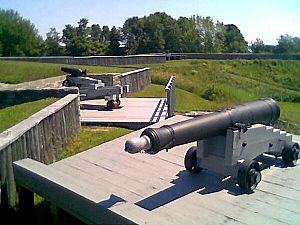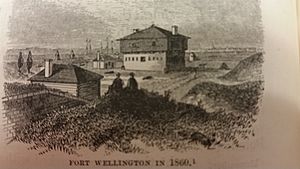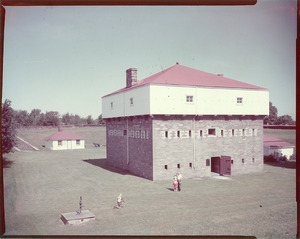Fort Wellington facts for kids
Quick facts for kids Fort Wellington |
|
|---|---|
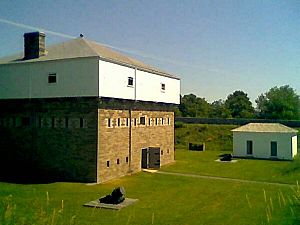
Fort Wellington's blockhouse and latrine from the southwest, 2006
|
|
| Location | Prescott, Ontario, Canada |
| Built | 1813–1814 |
| Original use | Military fortification (1813–14; 1838–1923) |
| Rebuilt | 1838–1839 |
| Architect | George R. J. Macdonnell and Thomas Pearson (first fort) |
| Governing body | Parks Canada |
| Website | pc.gc.ca/en/lhn-nhs/on/wellington/index |
| Lua error in Module:Location_map at line 420: attempt to index field 'wikibase' (a nil value). | |
| Official name: Fort Wellington National Historic Site of Canada | |
| Designated: | 30 January 1921 |
Fort Wellington National Historic Site is a historic military fort in Prescott, Ontario. It sits on the north shore of the St. Lawrence River. For over 100 years, it was used by the British Army and the Canadian militia.
The fort was first built during the War of 1812. The British needed to protect an important shipping route on the St. Lawrence River. After the war, the first fort was left to fall apart. A new, stronger fort was built in the same spot in 1838 during a time of political unrest called the Rebellions of 1837–1838.
The British Army used the fort until 1863. After that, the Canadian militia took over until 1923. Then, the fort was given to Parks Canada. Today, Fort Wellington is a National Historic Site and an open-air museum where you can learn about its history.
Contents
Why Was the Fort Built Here?
The British built Fort Wellington during the War of 1812 to guard the St. Lawrence River. The river was a superhighway for moving people and supplies. Near Prescott, a series of rapids made it impossible for large ships to pass through.
Goods had to be unloaded from big ships onto smaller boats called bateaux to get past the rapids. This made Prescott a very important transportation hub. The town of Ogdensburg, New York, was just across the river in the United States. This meant Prescott could be easily attacked.
Because all of Upper Canada (now Ontario) depended on this route, the town had to be protected. The fort was built on land owned by Major Edward Jessup, who founded Prescott.
History of the Fort
The First Fort and the War of 1812
The first fort was built in 1813. It had high walls made of earth, called ramparts. These walls were reinforced with sharp wooden stakes. A deep, dry ditch, or moat, surrounded the fort. The only way in was through a single gate.
The fort's most powerful weapons were two huge 24-pounder cannons. They could fire cannonballs all the way across the river into Ogdensburg. This meant any enemy ship trying to pass would be in danger.
Interestingly, Fort Wellington was never directly attacked. Its presence was enough to make the area feel safe and show that the British controlled the territory.
The Battle of Ogdensburg
In February 1813, the fort was used as a base for a surprise attack. Lieutenant Colonel George Macdonell led about 500 British and Canadian soldiers across the frozen St. Lawrence River. They attacked the American town of Ogdensburg.
The soldiers captured military supplies, cannons, and prisoners. This raid was a response to earlier American attacks on Canadian towns.
The Battle of Crysler's Farm
Later that year, in November 1813, an American army tried to sail down the river to capture Montreal. The American general, General Wilkinson, was so afraid of Fort Wellington's cannons that he had his soldiers get out and walk past the fort at night.
The soldiers from Prescott's garrison followed the American army. On November 11, the two sides fought the Battle of Crysler's Farm. The much smaller British and Canadian force won the battle. This victory helped save Montreal from being captured.
After the War of 1812 ended in 1814, the fort was no longer needed. The soldiers left, and the fort was abandoned.
A New Fort is Built
In 1837, some people in Canada rebelled against British rule. This was called the Rebellions of 1837–1838. Fort Wellington became an important base for the local militia. The government decided to rebuild the fort in 1838.
The new fort was built on top of the old earth walls. The stone buildings you can see at the fort today were built at this time. This includes the large, three-story blockhouse, the officers' quarters, and a cookhouse. The fort was also armed with new cannons.
The Battle of the Windmill
After the rebellions, many of the rebels fled to the United States. There, they found Americans who were eager to help them fight the British. They formed a secret army called the Hunter Patriots. They believed Canadians wanted to be free from British rule and were waiting for help.
In November 1838, a group of Hunter Patriots planned to attack Fort Wellington. Their landing at Prescott did not go well. Alert Canadian militiamen spotted their boat and started firing. The Hunters sailed downriver and took over a tall stone windmill and some nearby buildings. Their leader was a man named Nils von Schoultz.
The Canadian militia surrounded the windmill. They were soon joined by British regular soldiers and even a small British naval ship. On November 13, the militia attacked but could not capture the strong windmill.
A few days later, more British soldiers arrived with heavy artillery. On November 16, they attacked again. The Hunters were quickly forced back into the windmill. The heavy cannons fired at the windmill, but its stone walls were too thick.
However, Von Schoultz and his men realized no one in Canada was going to join them. They were running out of supplies and ammunition. Von Schoultz surrendered. The survivors were taken to Fort Henry in Kingston for trial. Von Schoultz and a few others were executed, while the rest were either pardoned or sent to Australia.
Life at the Fort After the Battle
After the rebellion, British soldiers stayed at Fort Wellington. If you visit today, you can see the fort as it looked in 1846. The soldiers there were part of the the Royal Canadian Rifle Regiment. This special regiment was made up of British Army veterans.
The soldiers' main job was to guard the fort and its military supplies. In 1863, the British Army left, and the Canadian militia took full control of the fort. It was used as a training base and was garrisoned during the Fenian Raids in 1866. During World War I, it served as a temporary stop for soldiers traveling to Europe.
Fort Wellington Becomes a Historic Site
Fort Wellington was named a National Historic Site of Canada in 1920. In 1923, it was handed over to Parks Canada, which takes care of it today. Parks Canada also looks after the site of the Battle of the Windmill.
The site is important for several reasons:
- It was a key defensive post during the War of 1812.
- It was the base for the successful attack on Ogdensburg in 1813.
- It played an important role during the Rebellions of 1837-1838.
- It was the base for troops who defeated the invasion at the Battle of the Windmill in 1838.
Today, you can visit Fort Wellington during the summer. Guides in historic uniforms show you around the restored buildings, including the massive blockhouse. A new visitor center has exhibits and even a wrecked gunboat from the War of 1812.


